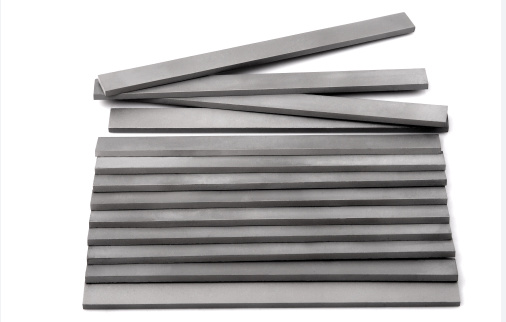カーバイド ストリップは、控えめでありながら強力な素材のリボンであり、数え切れないほどの産業で活躍する縁の下の力持ちです。木工、金属加工から建築、製造に至るまで、この万能ストリップは、驚くべき精度と効率で材料を切断、成形、変形させる力を与えてくれます。超硬ストリップの魅力に迫り、その特性、用途、そしてお客様のニーズに最適なストリップを選ぶ際に考慮すべき重要な要素についてご紹介します。
超硬ストリップとは?
超硬合金ストリップは、超硬合金の薄くて平らな部分であり、卓越した硬度と耐摩耗性で有名な複合材料です。このストリップは通常、非常に硬いことで知られる化合物である炭化タングステンの微粒子で構成され、結合材として機能するコバルトのマトリックスに埋め込まれています。

強さの錬金術:超硬ストリップができるまで
超硬ストリップの製造は、精密工学の賜物である:
- 粉末冶金: 炭化タングステンとコバルトの微粉末は、所望の特性を得るために特定の比率で精密に混合される。
- プレスと成形: この混合粉末を、専用の金型と高圧力を使って希望の形にプレスする。
- 焼結: プレスされたストリップは、制御された雰囲気の中で高温焼結プロセスを経る。焼結中、コバルト・バインダーが溶融して炭化タングステン粒子を融合させ、強固で緻密な材料が形成される。
- 仕上げ: 焼結後、カーバイドストリップは、所望の表面仕上げ、寸法、および特性を達成するために、研削、研磨、コーティングなどのさらなる加工を受ける場合があります。
多彩な世界:超硬ストリップの種類
超硬ストリップは、さまざまな業界の多様なニーズに対応するため、幅広い等級、サイズ、構成で提供されています:
超硬ストリップの特性一覧
| プロパティ | 説明 | 代表値 |
|---|---|---|
| 硬度(HRA) | 凹みと引っかきに対する耐性 | 88-95 |
| 横破断強度(TRS) | 曲げ力に耐える能力 | 1500-3000 N/mm² |
| 密度 | 単位体積当たりの質量 | 13.5-15.0 g/cm³ |
| 粒度 | 炭化タングステンの粒子径 | 0.5-10 µm |
| コバルト含有量 | コバルト含有率 | 6-12% |
表1:超硬ストリップの主要特性
注: 具体的な特性値は、超硬合金のグレードやメーカーによって異なる場合があります。
業界を超えたアプリケーション:超硬ストリップの輝き
超硬ストリップの多用途性は、その用途の広さからも明らかです:
- 木工: 広葉樹、合板、複合材加工用のソーチップ、ルータービット、切削工具。
- 金属加工: 切削工具、摩耗部品、金属加工、スタンピング、成形用の金型。
- 建設: コンクリートソー、道路切削工具、穴あけ装置用のカッティングエッジ。
- 製造: 様々な製造工程で使用される耐摩耗部品、ガイド、工具。
- その他の産業 超硬ストリップは、航空宇宙産業から医療産業まで、卓越した硬度、耐摩耗性、精度が最も重要な産業で使用されています。
競合を比較する超硬ストリップサプライヤー
| サプライヤー | 所在地 | 価格帯(1個あたり) | 特産品 |
|---|---|---|---|
| TRUER | グローバル | $5 – $50 | カスタム カーバイド・ソリューション高性能グレード |
| ケナメタル | 米国 | $10 – $75 | 幅広い標準グレードと特殊グレード |
| サンドビック・コロマント | スウェーデン | $15 – $100 | 要求の厳しいアプリケーションのための高度なコーティングと形状 |
| 京セラ | 日本 | $8 – $60 | 切削工具および摩耗部品用の高品質超硬合金 |
表2:超硬ストリップサプライヤーの比較
注: 価格は概算であり、等級、サイズ、数量、市況によって異なる場合がある。
長所と短所を天秤にかける:超硬ストリップの利点と限界
超硬ストリップ:良い点とそうでない点
| メリット | 制限事項 |
|---|---|
| 卓越した硬度と耐摩耗性 | 比較的脆く、衝撃で割れやすい。 |
| 高い切断効率と精度 | 他の素材に比べて高価な場合がある |
| 工具寿命が長く、ダウンタイムとコストを削減 | 機械加工や処理に特殊な設備が必要 |
| 様々な用途や素材に対応する汎用性 | すべての切断や摩耗の用途に適しているわけではありません。 |
表3:超硬ストリップの利点と限界
基本を越えて:超硬ストリップの興味深い事実
- ダイヤモンドのライバル 炭化タングステンは、ダイヤモンドに次ぐ硬度を持つ、人類が知る限り最も硬い素材のひとつである。
- 電球から道具まで: 炭化タングステンの主成分であるタングステンは、当初は白熱電球のフィラメントに使われていた。
- 宇宙時代の素材: 超硬材料はその極めて優れた特性から、ロケットノズルや宇宙開発用の切削工具など、航空宇宙用途に使用されている。
超硬ストリップのニーズにTRUERを選ぶ理由
TRUERは、お客様に卓越した結果をもたらす超硬ソリューションを提供することに情熱を注いでいます。TRUERが際立つ理由はここにあります:
- 妥協のない品質: 当社では最高品質の超硬材料を調達し、製造工程全体で厳格な品質管理措置を採用しています。
- カスタムソリューション: 弊社は、等級や形状からサイズや仕上げに至るまで、お客様独自の仕様に合わせた超硬ストリップの製造を専門としています。
- 技術的専門知識: 当社の超硬専門家チームは、専門的なガイダンスとサポートを提供し、お客様のアプリケーションに最適な超硬ソリューションを選択するお手伝いをします。
- グローバルなリーチ グローバルな事業展開により、世界中どこにいてもタイムリーな配送と迅速なカスタマーサービスを提供します。
よくある質問超硬ストリップに関するお問い合わせ
1.炭化物グレードと粒度の違いは何ですか?
炭化物グレードは、炭化タングステン、コバルト、およびその他の元素の特定の配合を指し、全体的な特性に影響を与えます。粒度とは、炭化物マトリックス内の炭化タングステン粒子の大きさを指し、硬度と耐摩耗性に影響します。
2.超硬ストリップは削れますか?
はい、超硬ストリップは、専用のダイヤモンド砥石と装置を使って研ぐことができます。しかし、最適な性能を発揮するためには、正しい角度とクリアランスを維持することが極めて重要です。
3.超硬ストリップを扱う際の安全上の注意点は?
超硬ストリップは非常に硬いため、落としたり取り扱いを誤ったりすると粉々になることがあります。超硬ストリップを取り扱う際は、必ず安全眼鏡、手袋、適切な衣服を着用してください。
4.用途に合った超硬ストリップの選び方は?
切削する材料、希望する切削品質、切削速度、送り速度、工具寿命の要件を考慮してください。超硬合金の専門家に相談すれば、最適な選択ができます。
5.超硬ストリップの寿命は?
寿命は、超硬グレード、用途、切削パラメータ、メンテナンスなどの要因によって異なります。適切な使用と手入れにより、超硬ストリップは卓越した工具寿命を実現し、ダウンタイムとコストを大幅に削減します。




